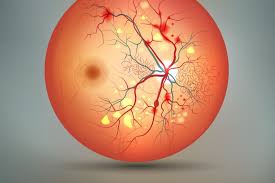
 Inherited retinal degenerations are inherited Mendelian disorders in which pathogenic variants of more than 280 genes cause dysfunction and death of the photo receptor cells of the retina: causing visual impairment.
Inherited retinal degenerations are inherited Mendelian disorders in which pathogenic variants of more than 280 genes cause dysfunction and death of the photo receptor cells of the retina: causing visual impairment.
An inherited retinal disorder (IRD) alters the structure and function of the retina and impairs vision.
Inherited retinal degenerations affect people across the age spectrum, and a leading cause of blindness worldwide.
Pathogenic variants of the gene encoding centrosomal protein 290 cause CEP 290 associated inherited retinal degeneration, a severe condition associated with visual impairment during the first decade of life.
Pathogenic variats of CEP290 in the most common cause of childhood genetic retina blindness (Leber’s congenital amaurosis).
In some children visual impairment is mild, but in others it is more severe.
IRDs are rare.
Most IRDs affect the light-sensitive cells that are known as photoreceptors, reducing or preventing responses to light in the retina and leading to vision impairment.
IRDs are inherited and cannot be prevented.
Some IRDs are degenerative, meaning they will worsen over time, but some remain stable throughout life.
The most common types of inherited retinal disorders include:
Leber congenital amaurosis (LCA)/early onset retinal degeneration.
Leber congenital amaurosis (LCA) causes severe visual impairment that starts as early as infancy.
Children with LCA may also have extreme farsightedness and crossed eyes.
Retinitis pigmentosa is a group of related sight disorders, attributed to the slow deterioration of the photoreceptor cells in the retina that respond to light.
Loss of night vision is often an early sign of X-linked RP, along with some visual acuity deficits, followed by the loss of peripheral vision.
Patients with achromatopsia have limited or no color vision, low vision acuity, and extreme sensitivity to light.
Achromatopsia is different from color blindness in that it also causes low vision and sensitivity to bright light.
Stargardt disease damages the macula, a part of the retina that provides straight-ahead vision.
Straight-ahead vision, is vision for seeing details such as small letters.
The onset of the disease is typically during childhood, but it might not be detected until adulthood.
It causes the loss of the central vision field. The loss of all vision is uncommon.
Cone-rod dystrophy is a group of related IRDs that involve the deterioration of the photoreceptors that are known as rods and cones.
Vision loss usually starting in childhood with symptoms such as poor vision and sensitivity to light.
Later symptoms include blind spots in the center of vision, loss of peripheral vision, and difficulty distinguishing colors.
Choroideremia affects males and is caused by a loss of retinal cells.
Choroideremia causes progressive vision loss: usually night blindness in childhood, followed by a gradual loss of peripheral vision, and eventually an inability to make out details.
Tunnel vision or complete blindness by adulthood are possible.
X-linked retinoschisis affects males and causes an early loss of central vision because the retinal layers split apart.
Vision may slowly deteriorate with age.
Congenital stationary blindness typically has early severe nearsightedness, low vision even with glasses on, and noticeable difficulty seeing in dimly lit conditions.
Inherited retinal disorders develops when there is a change in one or more genes that govern retinal cell structure and function.
Retinal cells are altered in their function, and often in their structure, leading to vision loss.
IRD symptoms depend on the type and severity.
IRDs might be quite stable, others cause loss of vision over a lifetime and some cause blindness.
An electroretinogram (ERG), is a test of retinal function that measures the electrical response of an eye’s light-sensitive cells the photoreceptors.
Genetic testing is also critical to reach a specific diagnosis.
There are no cures for most IRDs.
Care options: prescription glasses to improve visual clarity, tints and filters to lessen sensitivity to light, or surgery to repair the retina for those with advanced X-linked retinoschisis or those associated with complications from very high myopia.
Gene therapy is available for children who have LCA associated with the genetic Biallelic RPE65, where a copy of the working RPE65 gene to the retinal cells of the eye is injected beneath the retina.
This enables the retinal cells to make the RPE65 protein, which allows the visual cycle to continue and for light to be converted to electrical signals to be interpreted by the brain.
Place on ste
